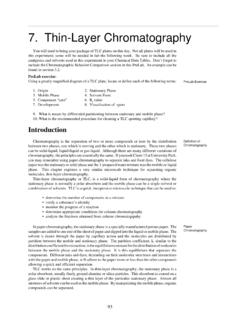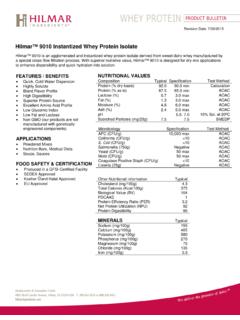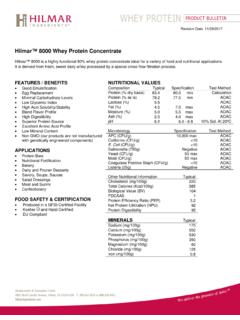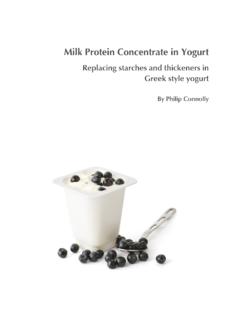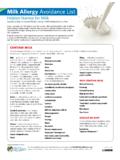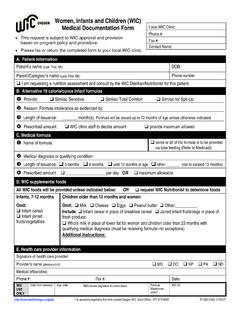Transcription of Isolation of Casein, Lactose, and Albumin from Milk
1 Exp t 112 Isolation of Casein, lactose , and Albumin from MilkAdapted by R. Minard (Penn State Univ.) from Introduction to Organic Laboratory Techniques: A Microscale Approach, Pavia, Lampman, Kriz & Engel, Saunders,1990. Revised 3/20/2000 PreLab Exercise:Draw a mechanism for the acid-catalyzed hydrolysis of the acetal bond in lactose ; see reaction : your textbook may be of some help; first identify the functional group that is undergoing a reactionand consider the catalyzed : The Chemistry of MilkMilk is a food of exceptional interest. Not only is milk an excellent food for the very young, but humanshave also adapted milk, specifically cow s milk, as a food substance for persons of all ages. Manyspecialized milk products like cheese, yogurt, butter, and ice cream are staples of our is probably the most nutritionally-complete food that can be found in nature.
2 This property isimportant for milk, since it is the only food young mammals consume in the nutritionally significantweeks following birth. Whole milk contains vitamins (principally thiamine, riboflavin, pantothenic acid,and vitamins A, D, and K), minerals (calcium, potassium, sodium, phosphorus, and trace metals),proteins (which include all the essential amino acids), carbohydrates (chiefly lactose ), and lipids (fats).The only important elements in which milk is seriously deficient are iron and Vitamin C. Infants areusually born with a storage supply of iron large enough to meet their needs for several weeks. VitaminC is easily secured through an orange juice supplement. The average composition of the milk of eachof several mammals is summarized in the accompanying Percentage Composition of Milk from Various milk is an oil-water type of emulsion, containing about 4% fat dispersed as very small (5-10microns in diameter) globules.
3 The globules are so small that a drop of milk contains about a million ofthem. Because the fat in milk is so finely dispersed, it is digested more easily than fat from any othersource. The fat emulsion is stabilized to some extent by complex phospholipids and proteins that areadsorbed on the surfaces of the globules. The fat globules, which are lighter than water, coalesce onstanding and eventually rise to the surface of the milk, forming a layer of cream. Since vitamins A and OHOOHOOOHCH2 OHOHHHOHOH2 COHOHOOHOHOHH2 COHHOOCH2 OHOHHHOHOH2OD-GalactoseD-Glucose+D-Galac tose+D-Glucose - lactose :H+D are fat-soluble vitamins, they are carried to the surface with the cream. Commercially, the cream isoften removed by centrifugation and skimming and is either diluted to form coffee cream ( half andhalf ), sold as whipping cream, converted to butter, or converted to ice cream.
4 The milk that remainsis called skimmed milk. Skimmed milk, except for lacking the fats and vitamins A and D, hasapproximately the same composition as whole milk. If milk is homogenized, its fatty content will notseparate. Milk is homogenized by forcing it through a small hole. This breaks up the fat globules andreduces their size to about 1 to 2 microns in fats in milk are primarily triglycerides; about two thirds of all the fatty acids in milk are saturated,and about one third are unsaturated. Milk is unusual in that about 12% of the fatty acids are short-chain fatty acids (C2-C10) like butyric, caproic, and caprylic lipids (fats and oils) in milk include small amounts of cholesterol, phospholipids, and lecithins(phospholipids conjugated with choline). The structures of phospholipids and lecithins are shown.
5 Thephospholipids help to stabilize the whole milk emulsion; the phosphate groups help to achieve partialwater solubility for the fat globules. All the fat can be removed from milk by extraction with petroleumether or a similar organic may be classified broadly in two general categories: fibrous and globular. Globular proteinsare those that tend to fold back on themselves into compact units that approach nearly spheroidalshapes. These types of proteins do not form intermolecular interactions between protein units (Hbonds and so on) as fibrous proteins do, and they are more easily solubilized as colloidal are three kinds of proteins in milk: caseins, lactalbumins, and lactoglobulins. All are is a phosphoprotein, which has phosphate groups are attached to some of the amino acid side-chains. These are attached mainly to the hydroxyl groups of the serine and threonine , casein is a mixture of at least three similar proteins, which differ primarily in molecular weightand amount of phosphorus they contain (number of phosphate groups).
6 Casein exists in milk as the calcium salt, calcium caseinate. This salt has a complex structure. It iscomposed of , , and caseins which form a micelle, or a solubilized unit. Neither the nor the casein is soluble in milk, singly or in combination. If casein is added to either one, or to a combinationof the two, however, the result is a casein complex that is soluble owing to the formation of the structure proposed for the casein micelle is shown on the following page. The casein is thought tostabilize the micelle. Since both and casein are phosphoproteins, they are precipitated by casein protein , however, has fewer phosphate groups and a high content of carbohydrate boundto it. It is also thought to have all its serine and threonine residues (which have hydroxyl groups), aswell as its bound carbohydrates, on only one side of its outer surfaces.
7 This portion of its outer surfaceis easily solubilized in water since these polar groups are present. The other portion of its surface bindswell to the water-insoluble and caseins and solubilizes them by forming a protective colloid ormicelle around them. Since the entire outer surface of the micelle can be solubilized in water, the unitis solubilized as a whole, thus bringing the and caseins, as well as casein, into caseinate has its isoelectric (neutrality) point at pH Therefore, it is insoluble in solutions ofpH less than The pH of milk is about ; therefore casein has a negative charge at this pH and issolubilized as a salt. If acid is added to milk, the negative charges on the outer surface of the micelleare neutralized (the phosphate groups are protonated) and the neutral protein precipitates:Ca2+Caseinate + 2 HCl Casein + CaCl2 The calcium ions remain in solution.
8 When milk sours, lactic acid is produced by bacterial action (seebelow), and the consequent lowering of the pH causes the same clotting reaction. The Isolation ofcasein from milk will be carried out in this casein in milk can also be clotted by the action of an enzyme called rennin. Rennin is found in thefourth stomach of young calves. However, both the nature of the clot and the mechanism of clottingdiffer when rennin is used. The clot formed using rennin, calcium paracaseinate, contains +Caseinate + rennin Ca2+Paracaseinate + a small peptideRennin is a hydrolytic enzyme (peptidase) and acts specifically to cleave peptide bonds betweenphenylalanine and methionine residues. It attacks the casein, breaking the peptide chain so as torelease a small segment of it. This destroys the water-solubilizing surface of the casein, whichprotects the inner and caseins and causes the entire micelle to precipitate as calciumparacaseinate.
9 Milk can be decalcified by treatment with oxalate ion, which forms an insoluble calciumsalt. If the calcium ions are removed from milk, a clot will not be formed when the milk is treated clot, or curd, formed by the action of rennin is sold commercially as cottage cheese. The liquidremaining is called the whey. The curd can also be used in producing various types of cheese. It iswashed, pressed to remove any excess whey, and chopped. After this treatment, it is melted, hardenedand ground. The ground curd is then salted, pressed into molds, and set aside to are globular proteins that are soluble in water and in dilute salt solutions. They are,however, denatured and coagulated by heat. The second most abundant protein types in milk are thelactalbumins. Once the caseins have been removed, and the solution has been made acidic, thelactalbumins can be isolated by heating the mixture to precipitate them.
10 The typical Albumin has amolecular weight of about 41, third type of protein in milk is the lactoglobulins. They are present in smaller amounts than thealbumins and generally denature and precipitate under the same conditions as the albumins. Thelactoglobulins carry the immunological properties of milk. They protect the young mammal until its ownimmune system has the fats and the proteins have been removed from milk, the carbohydrates remain, as they aresoluble in aqueous solution. The main carbohydrate in milk is , a disaccharide, is the only carbohydrate that mammals synthesize. It is synthesized in themammary glands. Hydrolyzed, it yields one molecule of D-glucose and one of this process, one molecule of glucose is converted to galactose and joined to another of galactose is apparently needed by the developing infant to build brain and nervous tissue.
